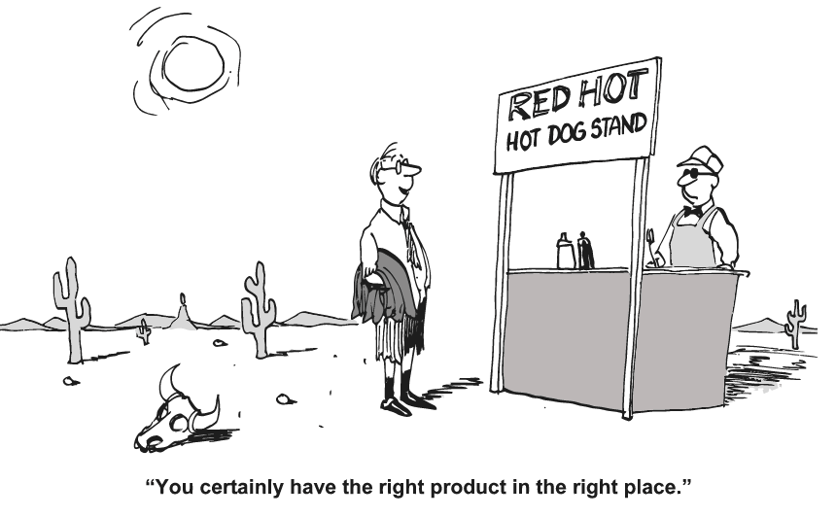If you want an easy-to-use smartphone that takes Instagram-perfect pictures, you may buy an iPhone. If you want lower rates on your auto insurance, you might hit up Geico.
While these brands could deliver just what you're looking for, you already had a mental association about their products and services. This is based on brand positioning.
Even if your organization isn't a household name (or anywhere close to it), you could benefit significantly from a brand positioning strategy. In crowded markets and industries, differentiating your company from your competition could be key A brand positioning strategy allows you to win the right types of new customers.
What is a Brand Positioning Strategy?
This is Important: Brand positioning is not brand identity.
While these two concepts are closely related, they're not one and the same.
Brand identity = your face.
Brand identity is how your business looks and feels to your customers. Typography, colors, logos, and brand values are all components of brand identity.
Brand positioning = your fit.
Brand positioning is why your prospects visit your website. It's about how you fit into your industry. It can determine why your customers buy from you, instead of your competitors.
In the words of Cult Branding, "brand positioning is the process of positioning your brand in the mind of your customer." The outcome of successful brand positioning is customers who "know" what you do, and why you're different than the rest.
What Does Bad Brand Positioning Look Like?
The most common brand positioning mistake is no brand positioning, which is also known as fuzzy positioning or "under positioning." If your unique value proposition (UVP) was your first and last attempt to differentiate, you might be suffering from fuzzy positioning.
Maybe your clients know that your company does catering. However, do they know that you're the only company who uses 100% organic ingredients? In your whole town? Or the only vegetarian-owned catering company who works with a major wedding venue?
Under positioning results in customers who don't know who you are. They don't understand how you're different. In many cases, you might not even come to mind since your brand doesn't occupy a clear space in their heads.
Other common positioning mistakes, per Management Study Guide, can include:
- Over-Positioning
If your business is so busy pushing a single product or service line, your customers may not be aware of your full scope. Over-positioning occurs when your positioning isn't comprehensive.
- Confused Positioning
When your positioning doesn't align with reality, resulting in confused customers.
- Double Positioning
When your customers just don't believe you. This can result from inaccurate brand positioning or poor reputation. You could see this with companies who have suffered a PR scandal.
The Recipe for Brand Positioning
To understand the recipe for a brand positioning strategy, it's important to think about why customers buy.
Customers buy from companies that have the right solution, meet the right criteria, and are trustworthy.
- Relevance
Do you offer the right types of product or service solutions? Can you solve a problem for your customers?
- Priorities
This second ingredient requires knowledge of your customers. Do they shop by budget or quality? What are their priorities and fears (pain points)?
- Trustworthy:
How can you back up your claims?
There's a fourth ingredient, which is appeal. Brands must be likable in order to make sales. Companies with a reputation for rude customer service or low-quality products don't last very long. Same goes for companies with terrible websites or little online presence.
However, likability isn't purely a result of positioning. A lot of your "look" and "feel" will have an impact on likability. This fourth ingredient is usually refined during brand identity development exercises.
Creating a Brand Positioning Statement
A brand positioning statement is a little bit different than your UVP. This statement should address your overall fit. It should encompass how you fit into your industry, and how you mesh with your target customers. Per Cult Branding, there are four elements to a brand positioning statement:
- Target Customer
Who is your ideal customer?
- Market Definition
Who are your competitors?
- Brand Promise
What does your company offer better than anyone else?
- Reason to Believe
Why should customers trust you?
A sample brand positioning statement could read as follows:
Danger & Co offers the most extreme sports gear to highly-competitive, athletic, young thrill-seekers. We are one of seven extreme sports gear companies in Colorado, but the only one whose gear is designed by a team of engineers and exercise physiologists. This guarantees top safety ratings and a competitive edge for pro athletes.
Your brand positioning statement doesn't need to be printed -- word-for-word -- on your website. However, it should be at the core of your content marketing strategy, and drive your website copy, blogs, and more.
Your first-time website visitors and prospects are basically in the process of asking "why." Why should they choose you instead of a competitor? Think of a well-written brand positioning statement as the answer to most your prospect's questions.

How to Evaluate Your Brand Positioning Strategy
Ideally, your brand positioning statement is a strong starting point. Once you've nailed who you are, and how you fit, you can begin infusing this strategy into your website, content marketing, and inbound. A brand positioning strategy can be used to refine your brand identity, brand story, and more. However, it's important to test-drive your branding.
If your marketing team's spent an hour working closely on a statement and strategy, you might not be the most objective audience. I recommend getting feedback from insiders and trusted outsiders, and using the following questions to evaluate your first draft.
1. Is it different than your competition?
Competitive analysis is critical to understand whether your brand strategy will work. If all of your competitors are making the same claims, your positioning won't advance one bit.
It's important to note that your strategy can have some similarities to your competitors. This may be natural in crowded markets. However, you've got to add some extra "punch" to your positioning. Maybe your target customer is slightly different, or you're just a little more trustworthy. Make sure at least one aspect of your positioning is genuinely unique.
2. Does it matter to your ideal customers?
If you don't know your customers, you can't give them what they want. Your brand's position should align perfectly with your customer's priorities and pain points.
If there's some friction between what you're offering and who you're trying to attract, it should be a red flag. You may need to revise your buyer persona profiles, perform more customer research, or revise your positioning.
3. Is it honest, and true to your brand?
Brand positioning should reflect who your brand is right now. It shouldn't reflect who you're trying to become in the next several years.
While it's important to draft a positioning strategy that can grow with your company (see question #6), your positioning must be relevant to the here-and-now. Otherwise, your messaging could come off as disingenuous.
4. Does it fit your values?
Ideally, there should be some overlap between what your company values, and what your customers value. Whether you offer convenience or originality, make sure this is reflected in your positioning.
5. Is it comprehensive?
To avoid the risk of over-positioning, make sure your company's entire mission is reflected in your brand positioning strategy. If your organization serves two distinctly different groups of customers, that's okay. However, make sure you're not excluding anyone.
6. Is it strong enough to drive your brand forward?
Your brand strategy may require slight revision over the next few years. If you were the Marketing Director at Danger & Co, you might hope to start selling snowboards and skateboards, in addition to extreme sports clothing. That's totally okay. While you may need to slightly "tweak" your brand strategy over time, it shouldn't change significantly.
While products and customer groups may evolve, your brand promise and reason to believe shouldn't. If these aspects of your positioning strategy aren't strong enough for the future, it's time to revise.
7. Will it be relevant in 10 years?
No marketer can look into the future with any certainty. However, aspects of your brand positioning strategy should be timeless. In other words, they should appeal to human values and priorities that won't change significantly in the near future.
- Examples of timeless consumer expectations could include:
- Personalized customer service
- Genuine relationships
- Efficiency and convenience
8. Could your competition co-opt it?
If your competitor were to hack into your computers, steal your brand positioning statement and copy-and-paste it word-for-word across their website, would they be lying? Illegal activities aside, the point is that your competitors shouldn't be able to steal your brand positioning. If they could, you need to differentiate further.
9. Is it appealing?
Appeal is a very subjective measure. It depends on your target customers. However, your brand positioning strategy should lend itself well to appealing branding -- including brand identity, brand stories, and more.
Your Brand Positioning Strategy
Without clear brand positioning, marketers may struggle to gain any ground. Developing a clear idea of how your brand "fits" into your industry and customers' lives and positioning accordingly can help you improve awareness, appeal, and more. By understanding your competition, your customers, and why you're different, you can begin to claim your company's unique space.





